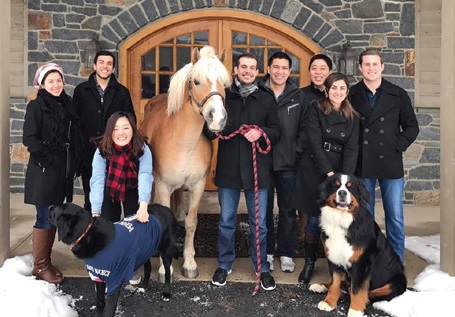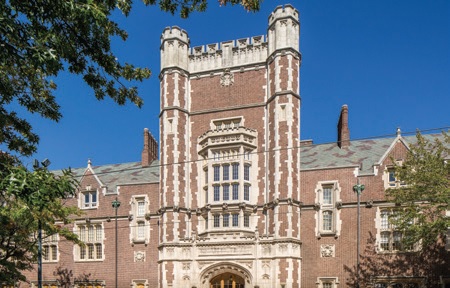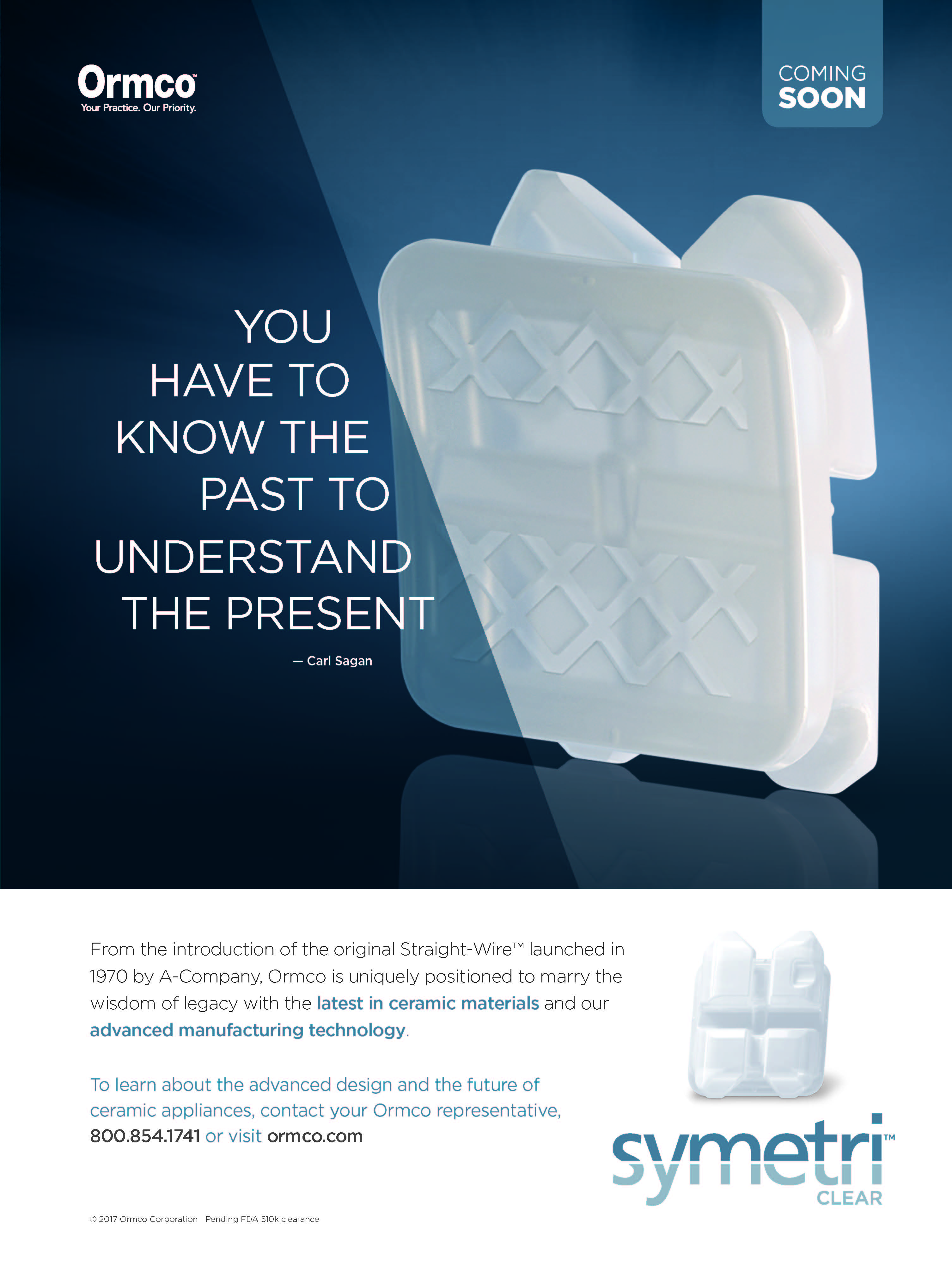2018 Eugene L. Gottlieb JCO Student of the Year: Dr. Samaneh Mojarrad
The Journal of Clinical Orthodontics is pleased to announce Dr. Samaneh Mojarrad from the University of Pennsylvania as the winner of the 2018 Eugene L. Gottlieb JCO Student of the Year Award, presented by American Orthodontics. Dr. Mojarrad was selected over 21 other students from schools around the United States in a two-stage, months-long competition judged by members of the JCO editorial board. Her prize includes more than $8,000 worth of materials and travel from American Orthodontics, JCO, and Dolphin, as well as a presentation ceremony during the Residents Reception at the AAO annual conference in Washington, D.C.
The Student of the Year Award is named to honor the legacy of JCO’s founding editor, Dr. Gottlieb. Dr. Mojarrad is the third awardee; she joins previous winners Dr. Moataz Elmahdy and Dr. Krystian Jarosz. The University of Pennsylvania is the third school to produce a winner over the three years of the competition.
Similar articles from the archive:
Any U.S. orthodontic department was eligible to nominate one current student by submitting two letters of recommendation and the student’s personal essay. Each student was then given the materials from an unpublished case and asked to write a complete treatment plan, including all possible alternatives, within two weeks. Three JCO editorial board members narrowed the initial group of 22 nominees down to 12 finalists in December. In the second stage, each of the finalists submitted an ABO-style case report. Moderated by JCO’s Editor, Dr. Robert Keim, the judging panel included Dr. John Graham of Salt Lake City; Dr. Neal Kravitz of South Riding, Virginia; Dr. Sarah Shoaf of Winston-Salem, North Carolina; and Dr. Peter Sinclair of Los Angeles.
As in past years, the judges were highly impressed by the quality of submissions. JCO will feature each finalist on our Facebook page in the coming months. Congratulations to Dr. Mojarrad and the University of Pennsylvania! Current orthodontic students and faculty can expect the start of the 2019 nomination process in August.
PHILIP B. VOGELS
VP of Marketing and Business Development
Q&A with Dr. Samaneh Mojarrad
Can you tell us a little about yourself?
I was born in Tehran, Iran, and moved to the United States with my family when I was two and half years old. I spent my childhood years in the suburbs of Northern Virginia and later moved back to Tehran, where I finished high school and attended dental school. If I sum up all the years moving back and forth, I can say I’ve spent half of my life in Iran and the other half here in the States. The experience of living in two countries with different cultures, customs, and traditions has shaped who I am today. I always joke that I have the best of both cultures instilled in me!
I come from a tight-knit family. My older sister is a dentist, my younger brother has a master’s degree in financial engineering and is a business analyst, and I’m the lucky middle child! My father has taught me that success is achieved through determination, hard work, and perseverance. My mother has always showered us with her unconditional love, devotion, and support. My family is my rock, my foundation, and my biggest blessing.
My greatest weakness is chocolate, so to satisfy my sweet tooth, I’ve developed a passion for baking and like to tweak recipes with healthy swaps. I enjoy spending time with my family, exploring new restaurants and cuisines with my friends, hiking, and painting.
Why are you pursuing a career in orthodontics?
As Rumi said, “Let the beauty of what you love be what you do.” My love for art and passion to provide care for those in need sparked my interest in pursuing a career in orthodontics. In my opinion, orthodontics is a true collaboration between art and science. A unique story lies behind each smile. For some, it is to have straighter teeth; for others, to have a functional bite; but for most, it is a transformational journey to discover their inner confidence and beauty. It is gratifying to be in a profession that enables me to impact people’s lives in such a positive and meaningful way while building lifelong relationships in the process. I feel honored that patients and parents put their trust in me. My gift to them is crafting a healthy, beautiful smile, a work of art to be admired for many years.
Can you describe the path that led you to the University of Pennsylvania?
My dental journey began at the National University of Iran School of Dentistry. After graduating in 2011, I moved back to the United States to further my clinical skills, take advantage of research opportunities, and follow my dream of becoming an orthodontist. I started my second round of dental education at Boston University’s Goldman School of Dental Medicine. I value the clinical skills I gained during my training and the opportunity to collaborate with like-minded students in serving neighboring communities through our American Student Dental Association outreach programs. During the interview process, I was mesmerized by the beautiful architecture and rich history of the University of Pennsylvania dental program. I was impressed with the scope of the program and the unlimited array of research opportunities it offered, but what stood out to me the most were the humility of the interviewers and the common passion they shared for the program. I knew right away that Penn was the best fit for me. Match day was a dream come true! I will forever be grateful for the opportunity that was given to me and for the solid academic and clinical foundation our orthodontic program has provided me.
What has surprised you the most during your orthodontic education?
How unique each case is, and the depth of thinking and planning that is involved. It’s like solving a puzzle! One by one you put together the bits and pieces of all the information you’ve gathered, and as the problems become clearer, you start to envision your end goal. From all the possible paths you can follow to treat a patient, you pick the best one and finally execute your plan. It’s mentally intriguing, and I love it!
What has been the most difficult part of becoming an orthodontist?
Learning what my limitations are and that the ideal vision I have is not always practical. I’ve always been amazed at how a profession that works within a range of a few millimeters can have such a huge impact on people’s lives, and as a result of that, I think that deep down we all feel like superheroes. It’s hard to accept sometimes that our superpowers are limited!

Dr. Mojarrad, orthodontic classmates, and friends take a break from ABO reviews. Left to right: Drs. Manal Sabir, Robert Vincelli, Brianna Yang, Michael Capogna, Isaac Chung, John Park, Samaneh Mojarrad, and Matthew Cassera.
What, so far, has been your most rewarding orthodontic experience?
My time spent in residency and the lifelong relationships I’ve developed with my co-residents and faculty members. Every morning as I walk down “Locust Walk,” I am reminded of how fortunate I am to learn from individuals who are pioneers of our profession, gracious with sharing their abundance of knowledge, selfless in telling their stories of success and failures, and always reminding us to be compassionate toward our patients. I love my Penn Ortho “family” and will cherish every memory I have from residency!
What has been your most difficult case so far?
My most difficult case during residency was treating a 36-year-old female who had skeletal discrepancies in both the sagittal and transverse dimensions. She had a Class II, division 1 malocclusion; a bilateral posterior crossbite; a posterior bite collapse due to the loss of multiple teeth, with flaring of the upper incisors; and an impinging deep bite. Her treatment required an interdisciplinary approach. Ideally, she would have benefited from orthognathic surgery to address the underlying skeletal discrepancies, but she did not have insurance and could not afford the cost of surgery. We were limited to treating her with a camouflage orthodontic plan. Through this case, I learned to utilize a bite plane in a periodontally compromised patient while uprighting molars and establishing the posterior bite, and to use an intrusion arch to correct supraerupted lower incisors. I also learned how to effectively use edentulous spaces to retract flared upper incisors while maintaining maximum anchorage with temporary anchorage devices (TADs). It was indeed a challenging case, but I learned valuable treatment mechanics and how to collaborate with multiple specialties to provide optimum patient care.
Any research projects you’d like to tell our readers about?
As a dental student in Iran, I was fascinated by the potential and vast application of stem cells in tissue regeneration. Therefore, as part of my dental thesis, I conducted research to isolate mesenchymal stem cells (MSCs) from dental tissue. While working on my research and writing my thesis, I read multiple articles from such pioneers in the field of tissue regeneration as Dr. Songtao Shi. Little did I know that four years later, I would be an orthodontic resident at the University of Pennsylvania and would have the opportunity to work with him as my mentor for my master’s research! Currently, I am investigating the underlying cellular activity and response of midpalatal suture MSCs to expansive forces in a mouse model.
What are your postgraduate plans?
As a resident, I love the days I’m on teaching duty, when I get to walk my dental students through initial orthodontic evaluations and consults and lecture about orthodontics. Ideally, I would like to expand my clinical skills by working in a private practice while being involved in academia through teaching.
What do you think orthodontics will look like in 10 years?
I see a shift toward fully equipped digital orthodontic practices as intraoral scanners replace traditional alginate impressions, three-dimensional cone-beam computed tomography replaces the standard two-dimensional technology, and 3D printing becomes more common. As more adults seek orthodontic care and teenagers become more self-conscious about their appearances (#PowerOfSocialMedia), there will be an increased demand for treatment options that are more esthetic, such as clear or lingual braces and clear aligners. In an era in which “time is gold” and life is fast-paced, a shift toward customized treatment plans that are more effective and efficient is inevitable.
Rapid-Fire Round
How can orthodontists thrive in today’s competitive marketplace, particularly with the increase in dentists offering various forms of orthodontics?
As long as we strive to provide excellent patient care that is second to none, keep our knowledge and clinical skills current, and continue to support one another, we will only grow stronger as a profession moving forward.
Social media: Should it be a major tool in an orthodontist’s marketing arsenal?
Yes, social media is an integral part of our day-to-day lives; it is here to stay and will only continue to grow. It is a powerful tool that should be used not only for marketing but also to portray the positive impact of our profession, to educate the public, and to promote our specialty.

Thomas W. Evans Building, School of Dental Medicine, University of Pennsylvania, Philadelphia. (Photo courtesy of University of Pennsylvania.)
Clear aligners: What malocclusions should they be considered or not considered for?
In my opinion, clear aligners or braces are only tools that help us move teeth. The underlying biology of tooth movement will always remain the same. Whether we decide to treat a certain malocclusion with braces or clear aligners depends on patient preference and the practitioner’s clinical expertise.
TADs: Are we moving toward too much TAD usage, or will applications continue to increase?
TADs are an excellent tool for enhancing treatment mechanics and treating borderline surgical cases, such as correcting transverse discrepancies in non-growing patients, enhancing vertical control and molar intrusion for open bites, or providing maximum anchorage in bimaxillary protrusion cases. I believe TADs will be used increasingly in adults, not only because more adults are seeking treatment, but also because the cases are often complex and multidisciplinary in nature and these patients demand less invasive alternatives.
Extraction: Where do you stand on the debate?
It is a case-by-case decision based on severity of the malocclusion, facial esthetics, soft-tissue balance, and parent and patient autonomy.
Retention: Should patients always be pushed toward permanent retention, and how long should we continue to see them on recall visits?
Once a year post-debonding and for as long as our patients like to see us afterward! Retention design (fixed vs. removable) should be discussed with patients and tailored to the specific needs and initial malocclusion. Patients should be educated that growth is lifelong and teeth will continue to shift throughout life. Whether a patient commits to maintaining treatment results permanently is a personal choice.
Phase I treatment: Overused, underused, or properly used?
The answer to this question varies based on one’s treatment philosophy and area of practice. From my experience during residency, it was properly used. I believe that early intervention is needed and can be beneficial for some cases with Class III malocclusion, transverse discrepancy, or proclined upper incisors with a high risk of trauma.
Accelerated orthodontics: What does the future hold?
Accelerated orthodontics will remain as an adjunct to orthodontic care. As the demand for faster and more efficient treatment increases, we will continue to see more research and innovation in this field.


